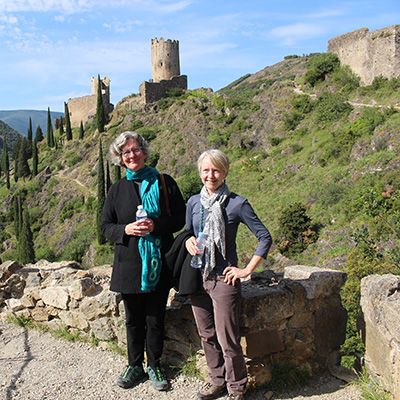Pilgrimage

Honors Passport: Pilgrimage
May 12-27, 2018
Honors College study abroad grant funding available
Pilgrimage invites ambitious honors scholars to follow in the footsteps of famous figures from the medieval era: kings, queens, abbesses, abbots, mendicants, scholars, warriors, and heretics. Our journey begins amidst the Gothic splendors of medieval Paris—the starting off point for one leg of the famous Camino de Santiago—and terminates at the “end of the world” in Finisterra, Spain. Along the route, students confront a diversity of landscapes, languages, and landmarks, all of which relate to the overarching theme of journey, both medieval and contemporary.
The trek moves back and forth between disparate epochs. At Arles, the Roman amphitheater stands as an ancient witness to the martyrdoms of early Christians, themselves objects of pilgrimage. The Romanesque fortress churches of Languedoc, their “armor-clad” façades mirroring to this day the militaristic impetus of the crusades, serve as reminders of religious violence in the southern lands of medieval France. The portals of medieval cathedrals, from Conques to Compostela, narrate for the pious stories of sin and salvation, crusader and infidel.
Each student in Pilgrimage will be assigned a monument to teach on site, ranging from the crusade-inspired repertoire of stained glass at Ste-Chapelle to the “heretic” fortress at Puilaurens. Additionally, students will walk sections of the medieval camino: a 10-km hike into the gorgeous Romanesque city of Conques; a climb up the Pyrenees from Urdos over the Somport pass; and a final, invigorating jaunt along the rim overlooking the stormy Atlantic from Muxia to Finisterra. This segment of the ongoing Honors Passport will train students at ground level how to interpret the fabric of medieval cities within their vibrant modern contexts. In all, participants in Pilgrimage will evaluate the inspiration behind modern pilgrimage haunted by a tumultuous medieval past.
What's in it for you:
- Experience and understand the spatial context behind major events in medieval politics and religion.
- Refine your teaching skills while you become an expert on key monuments or pivotal events.
- Analyze transformations in medieval art and architecture from Paris to Santiago de Compostela.
- Determine the extent to which today's Camino de Santiago is an "invented tradition" of modernity.
What's required from you:
- You will research and present a monument or event on site.
- You will complete required reading for the course.
- You will keep a journal of the pilgrimage.
- You will participate in on-site discussions related to the major themes of the pilgrimage.
Course Credit:
All students: Three hours of honors credit
Fulbright students: Art History/ARHS 3923H OR Humanities Colloquia/HUMN 3923H
Architecture students: ARCH 4023H
Count me in! Apply here.
About your professors: Honors College Dean Lynda Coon has launched a series of innovative honors courses since joining the history faculty
in the J. William Fulbright College of Arts and Sciences in 1990. She helped to create
the Honors Humanities Project (H2P) and as dean she has developed Signature Seminars, Forums, Retro Readings courses and this Honors Passport study abroad experience. Coon’s research focuses on the history of Christianity from circa 300-900. Her first
book, Sacred Fictions: Holy Women and Hagiography in Late Antiquity, explored the sacred biographies of holy women in late antiquity. Her second book, Dark Age Bodies: Gender and Monastic Practice in the Early Medieval West, focused on the ritual, spatial and gendered worlds of monks in the Carolingian period
(ca. 750-987). She is currently researching a book on imagining Jesus in the Dark
Ages.
Honors College Dean Lynda Coon has launched a series of innovative honors courses since joining the history faculty
in the J. William Fulbright College of Arts and Sciences in 1990. She helped to create
the Honors Humanities Project (H2P) and as dean she has developed Signature Seminars, Forums, Retro Readings courses and this Honors Passport study abroad experience. Coon’s research focuses on the history of Christianity from circa 300-900. Her first
book, Sacred Fictions: Holy Women and Hagiography in Late Antiquity, explored the sacred biographies of holy women in late antiquity. Her second book, Dark Age Bodies: Gender and Monastic Practice in the Early Medieval West, focused on the ritual, spatial and gendered worlds of monks in the Carolingian period
(ca. 750-987). She is currently researching a book on imagining Jesus in the Dark
Ages.
Kim Sexton, an associate professor of architecture at Fay Jones School of Architecture and Design, specializes in the architecture of late medieval and Renaissance Italy. Since joining the Fay Jones School's faculty in 1999, Sexton has taught survey courses in the history of world architecture, specialized courses on medieval and Renaissance architecture, and space and gender theory. Sexton is currently completing a book manuscript entitled Loggia Culture: Spatial Practices in Medieval Italy that positions the loggia or portico in cultural history. Her latest book, Architecture and the Body, Science and Culture is forthcoming from Routledge Research in Architecture. She served as director of the honors program for the Fay Jones School and as the Arkansas State Representative on the Board of Directors of the Southeastern Society of Architectural Historians.
Dean Coon and Professor Sexton have taught the second semester of H2P since 1999. They also developed Medieval Bodies/Medieval Spaces, an interdisciplinary honors colloquium that traces the evolution of western medieval
history through text, ritual and built environments. They are currently collaborating
on an article titled "Racetrack of Salvation: The Circus and the Martyr," which links
six unusual, football-field-sized 4th-century basilicas with Roman athletic structures
and Christian martyrs.
Questions? Contact Lynda Coon.